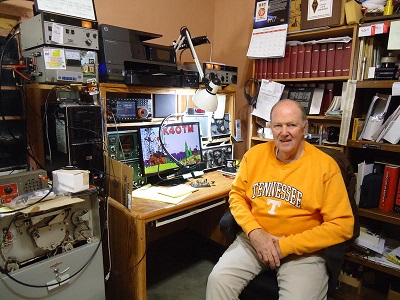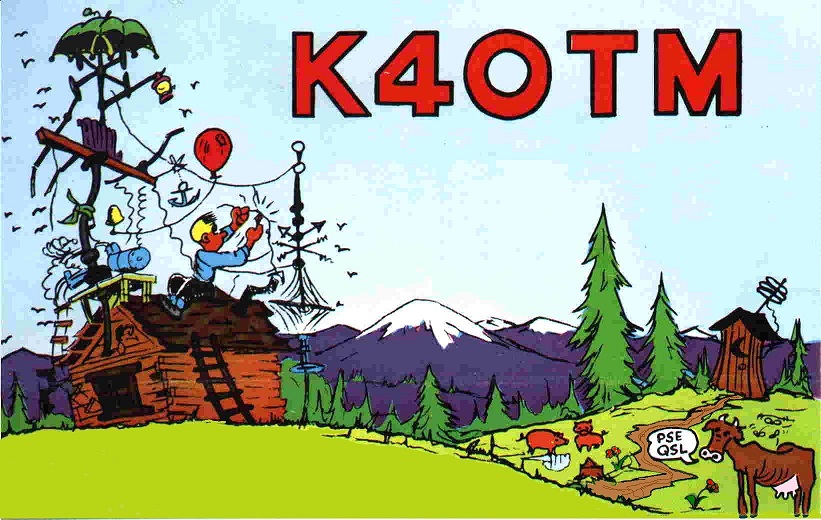 |
K4OTM Thomas N. 'Tom' Austin San Angelo, TX QCWA # 35629 |
The Greeneville, Tennessee Optimist Club, which happened to have several members who were hams and had engineering or technician jobs at Magnavox Inc., offered classes in basic electronics and Morse code. I was lucky enough to have entered the classes very near the beginning in the Fall of 1956. As a part of the class each participant had the opportunity to build a novice transmitter built on a surplus ARC-5 chassis and a power supply was homebrewed from obsolete television parts donated by the Magnavox Company. The transmitter used only the ARC-5 chassis along with some of the coils and variable capacitors since the original unit had VFO frequency control which was not permitted for use by Novice class licensees. We were not told that we were stripping down perfectly good transmitters. Of course we would not have learned nearly as much had we just tried to use the transmitters as they were. As I recall, we had to pay the princely sum of $5.00 each for the surplus transmitters. After completing this program, I was first licensed as KN4OTM on April 19, 1957 my initial rig was an ARC-5/BC-696A with a Hallicrafters S-76 Receiver donated by my Dad. I finally managed to pass my General class exam in 1958. A summer job earned me the cash for a used Johnson Viking II and VFO. The Viking II served me well for about a year before I got the itch for more power after a friend, K4HJZ in Douglas GA, offered to trade his BC-325B for my Viking II. I took the deal and was joyfully on the air with 800 Watts. It was a kind of heady experience. My dad finally put his foot down and banished me and the BC-325 to the garage. That was fine until winter came. Then it was more than a bit chilly. My "prized transmitter" stood just under six feet tall and weighed 850 lbs. It soon became known as "The Fridge. by the rest of my family. Dad ruled that it could go no further than the garage so my shack had to leave my bedroom.
This was my station until time for college! Obviously the BC-325B (The Fridge) could not go. I took the S-76 so that I could listen but it didn't take me too long to figure out that just listening was not good enough. I had a BC-653A with the DM-42 dynamotor in the garage gathering dust so... I built a wooden tray that would allow me to "mount" it in the rear seat of my Valiant Station Wagon. I commandeered my dad's portable Magnavox all band receiver and suddenly I was mobile. The set up worked pretty well despite the noise of the dynamotor. The DM-42 draws 42 amps running and who knows what the starting current was. This high current draw killed 3 alternators before I decided there had to be a better way. Another summer's work provided the cash for a brand new Gonset G-76 transmitter/receiver with AC and DC supplies. This time mobile was for real and operation from the dorm room was a possibility despite a prohibition of outside wires or antennas. It was time to get creative. First I tried an "invisible" antenna using very fine steel wire used as a recording medium in early audio recording devices. This wire gave very poor results as the wind kept breaking it. Then came INSPIRATION! I noticed that the guttering on the dorm was all copper with the joints soldered, attached to a brick (read ceramic) wall. Being on the top floor, I simply removed the screen from my window and scraped a bare place on the gutter. An alligator clip and short piece of wire later along with grounding to the copper heating system pipe and I was on the air in my dorm room. My first contact was on 80 mtr CW from Knoxvillle, TN to Long Island, NY. Hollow State and a PI network sure beats solid state, fold back circuits and broadband output in a situation like this. The G-76 took me through college but SSB was winning the battle of the bands so I added a Johnson Pacemaker to the shack and used the G-76 as the receiver. It worked but not well. Being single and having a real job enabled me to buy an HRO-500 which made SSB truly fun for the first time. Then life got complicated, marriage and then work took me to Belgium for about 7 months. (I had the call ON8VZ but was not able to get on the air) On my return, I let the Pacemaker go and bought a used Johnson Invader 2000 and was on the air with my first kilowatt. Life was good! This rig saw me through the next several years with another move to Mobile, AL. In 1969 NCR's Signal One division announced their "CX-7 Deluxe Integrated Station". I had to have it. I was able to get on the list early and had the bitter-sweet privilege of receiving serial #8. It was actually a Work in progress. I had to replaced boards and upgrade the rig on a regular basis. After wrestling with the Signal One for several years, I finally had the fatal screen grid to control grid short in the 8072 final amp tube. This destroyed several sections of the power supply as well as the 8072 final. I can no longer remember the name of the repair person who modified the rig into a CX7-B. This included new power supplies and LED readout. From this point on, the rig worked very well. Being "snake bit" by nature, lightning struck and destroyed the CX7. Since the CX7 was no longer available, the insurance company elected to replace it with a CX11A. Who was I to decline? This was really a beautiful radio. I also added an Alpha78 which worked very well. I used it daily from 1980 until 1994.
In the eighties and early nineties, I began collecting some of the older tube type radios that I wished I could have afforded in my high school and college days. Among those was a KWM-2A.That I purchased for $200 at the Sevierville, TN Hamfest. It didn.t work but the only problem was a broken lead on a ceramic resistor (R-86) in the B+ circuit. I fixed that and the radio then played beautifully and still does. In 1994 I found one of the true shortcomings of "no tune", broadband output circuits. I received a call from a ham in Ohio while I was Net Control for the Tennessee Phone net on 3.980 MHz I had a spurious signal somewhere down in the middle of the 75 meter band. This fellow had heard me on several evenings and looked up the net frequency. As I later found out, some of the later production CX11s were constructed with poor quality interstage RF connectors. The RF that was allowed to escape, mixed inside the radio and resulted in unwanted frequencies being radiated. The broadband output circuit in the finals of both the CX11 and the Alpha78 were more than happy to pass these spurious signals on to the antenna. The fix required that the radio be completely disassembled in order to replace all of the bad connectors. I elected to sell. I fell back on my KWM2-A to stay on the air, "Hollow State" to the rescue again. That was my station until about 1996 when I bought a Ten-Tec Paragon and later a Titan amplifier. It wasn.t long before I upgraded to a Paragon II. Today, I still use Ten-Tec almost exclusively as my primary rig , an Omni VII with the Titan amplifier. I also operate K4OTM/m using a Ten-Tec Model 599 Eagle, on a regular basis.
The KWM2-A must be bullet proof as is demonstrated by the on air compliments it continues to receive now in 2015. I have also had the good fortune to acquire a 30S-1 amp, at a very reasonable price, to go with it. The Collins rigs still provide a strong backup for my Ten-Tec primary station. I am now in the process of selling most of my .boatanchors.. My wife, N4WES, got me to agree to get rid of most of the radios that I can no longer lift (at age 73).
I have been blessed with good fortune in that the decision that I made in 1957, to join the ranks of amateur radio operators, is bringing me at least as much fun and enjoyment now as it did then.
73 es GB to all. Tom K4OTM

June 04, 2015